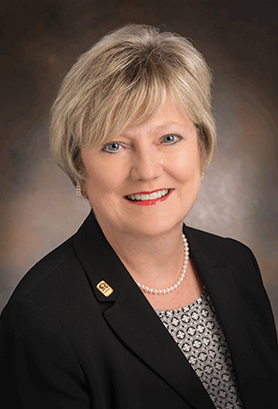2016 CEOs Who 'Get It'
The National Safety Council recognizes seven leaders who demonstrate a personal commitment to worker safety and health

 |
 |
Carol Johnson
President and CEO
Savannah River Nuclear Solutions
Aiken, SC
 |
Accomplishments
SAVANNAH RIVER NUCLEAR SOLUTIONS manages and operates the Savannah River Site in Aiken, SC. A key facility in the U.S. Department of Energy complex, SRS is dedicated to environmental stewardship, supporting the nuclear weapons stockpile and nuclear materials management and storage. SRNS employs 5,000 workers. |
Mentioned in Congress: Rep. Joe Wilson (R-SC) announced Carol Johnson's "CEOs Who 'Get It'" recognition Feb. 3 on the floor of the U.S. House of Representatives.
Why is safety a core value at your organization?
The Savannah River Site is steeped in a half-century-old culture of excellence in the nuclear industry. We solve some of the world’s most challenging – and pressing – nuclear challenges each and every day. To do this, we operate as a highly diverse and technical team. But more importantly, safety is a core value because we care about each other, our community and our country. At SRNS we believe that our work makes the world safer, and we are only successful at achieving this when safety is the foundation in all that we do, both on the job and off.
Describe your personal journey to becoming a CEO who “gets it.” What experiences or lessons brought you to where you are now?
Very early in my career I worked for DuPont. The DuPont safety culture and safety programs taught me the basics of why safety must be integrated into everything we do every day. Processes, procedures and human behavior require constant vigilance and periodic refresh. I learned the value of employee engagement and willingness to listen and respond to workers’ suggestions and issues. These are the people who are actually tasked with performing the important work of the company. The training and coaching from very experienced co-workers and supervisors many years ago gave me the indoctrination I needed relative to safety as I advanced in my career. I never forget and constantly remind myself of the grassroots worker involvement necessary for a strong safety culture.
What is the biggest obstacle to safety at your organization, and how do you work to overcome it?
I think the biggest challenge that SRNS faces is complacency. SRNS employs a highly skilled and technical workforce. As such, many employees are seasoned veterans with decades of experience in the nuclear industry. Although that is a positive attribute for any company, it also brings with it a unique challenge: ensuring employees stay engaged in the routine and possibly mundane requirements that are designed to keep us safe. We combat this challenge in multiple ways. First, we take a very deliberate approach to communications. Challenges are never overcome by denying their existence. Therefore, we openly discuss complacency with our workforce on a routine basis. Second, we utilize a robust continuous improvement program to inspire employees to help identify new and innovative ways to conduct business. This helps keep seasoned employees engaged, and leverages their experience to help SRNS achieve its missions in a safe and cost-effective manner. Lastly, we employ safety programs like behavior-based safety and the Integrated Safety Management System methodology to empower employees to speak up when safety is called to question. The success of these programs in combating complacency is largely driven by strong expectations set forth by senior leadership, as well as a healthy recognition program that is specifically designed to encourage employees to identify hazards that may lead to safety incidents.
How do you instill a sense of safety in employees on an ongoing basis?
Safety and security are engrained in everything that we do, from front-line workers to senior vice presidents – there is not a single SRNS employee who is not touched with a safety message every day. These fundamental values are visible from the moment employees enter the 310-square-mile site, where they are greeted daily by a robust communications campaign that reinforces our branded safety culture through multiple avenues. We also instill our safety culture into every employee through training, mentoring, leadership development and a team approach to safety success. This cultural expectation is reinforced each and every day by incorporating safety discussions before every work package is started. Safety is not just a condition of employment for SRNS employees; it is a way of life. Because of our safety culture legacy and indoctrination approach, employees take safety very personally and look for creative ways to continuously improve safety culture and systems at SRS.
How does your organization measure safety?
Leading indicators serve as our safety compass at SRNS. We utilize a spectrum of indicators that are both formal and informal to keep a pulse on the health of our safety performance. From monthly safety culture surveys to behavior-based safety observations, management field observations and a robust safety reporting system, we are able to monitor safety performance at all levels of the organization. Additionally, just trusting our intuition when we feel trouble is on the horizon. I am a firm believer that intuition is a powerful leading indicator and we often brush it off because there may not be the hard data to support our gut feelings.
What role does off-the-job safety play in your organization’s overall safety program? What types of off-the-job safety and health programs does your organization offer to employees?
Off-the-job safety is a wonderful indicator of overall safety culture. If employees are safe at home and in the community, then they have safety engrained in them as a personal value. Safety is really all about what you feel inside – it has to be internalized and in your heart. Every meeting at SRNS kicks off with a “safety share.” A great deal of these safety shares are personal experiences encountered after-hours or on weekends. But to bolster off-the-job safety, SRNS has included off-the-job observations in our behavior-based safety observation system. This helps keep continuity in safety focus and performance at work and at home. We also have implemented several wellness programs to inspire employees to take control of their health by rewarding healthy lifestyle choices through health insurance incentives.
Post a comment to this article
Safety+Health welcomes comments that promote respectful dialogue. Please stay on topic. Comments that contain personal attacks, profanity or abusive language – or those aggressively promoting products or services – will be removed. We reserve the right to determine which comments violate our comment policy. (Anonymous comments are welcome; merely skip the “name” field in the comment box. An email address is required but will not be included with your comment.)

